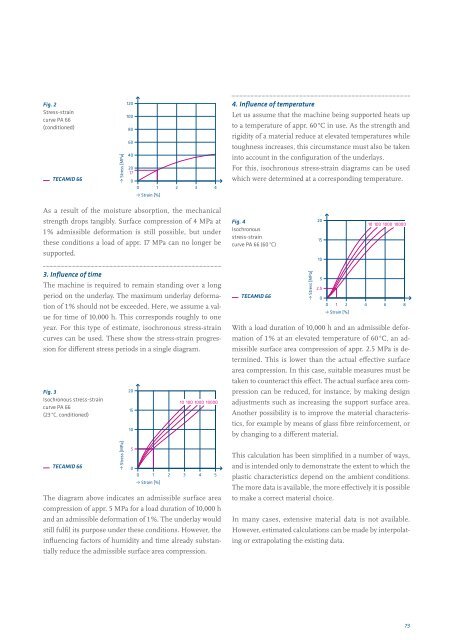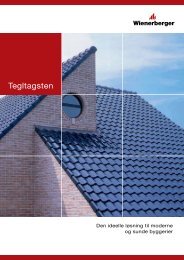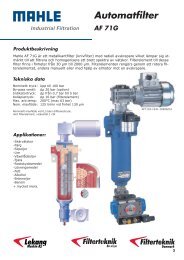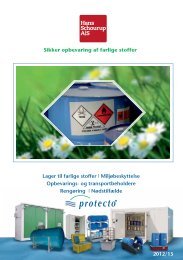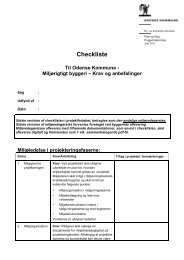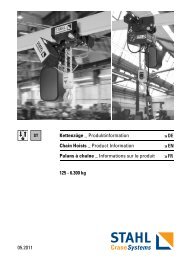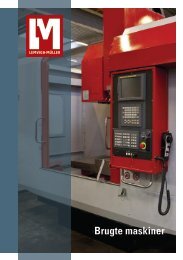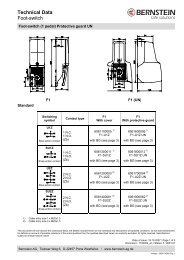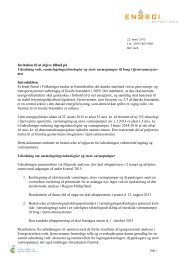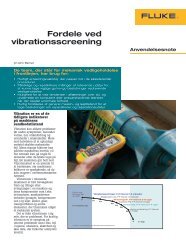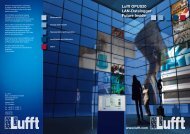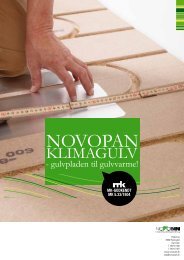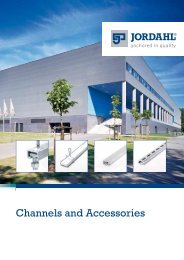Engineering plastics â The Manual - F.wood-supply.dk
Engineering plastics â The Manual - F.wood-supply.dk
Engineering plastics â The Manual - F.wood-supply.dk
Create successful ePaper yourself
Turn your PDF publications into a flip-book with our unique Google optimized e-Paper software.
0<br />
0<br />
0<br />
0<br />
0<br />
5<br />
0<br />
0<br />
Fig. 2<br />
Stress-strain<br />
curve PA 66<br />
(conditioned)<br />
TECAMID 66<br />
0 1 2 3 4<br />
• Stress [MPa]<br />
120<br />
100<br />
80<br />
60<br />
40<br />
20<br />
17<br />
0<br />
0 1 2 3 4<br />
• Strain [%]<br />
4. Influence 20 of temperature<br />
Let us assume that the machine 10 100 1000 being 10000 supported heats up<br />
15<br />
15<br />
to a temperature of appr. 60 °C in use. As the strength and<br />
rigidity of a material reduce at elevated temperatures while<br />
10<br />
10<br />
toughness increases, this circumstance must also be taken<br />
into account in the configuration of the underlays.<br />
5<br />
5<br />
For this, isochronous stress-strain diagrams can be used<br />
2.5<br />
which were determined at a corresponding temperature.<br />
0<br />
0 1 2 3 4 5<br />
20<br />
0<br />
0 1 2 4<br />
10 100 1<br />
As a result of the moisture absorption, the mechanical<br />
strength 20 drops tangibly. Surface compression of 204 MPa at<br />
1 % admissible deformation 10 100 1000 is 10000 still possible, but under<br />
15<br />
15<br />
these conditions a load of appr. 17 MPa can no longer be<br />
supported.<br />
10<br />
10<br />
Fig. 10 4 100 1000 10000<br />
Isochronous<br />
stress-strain<br />
curve PA 66 (60 °C)<br />
20<br />
15<br />
10<br />
10 100 1000 10000<br />
0<br />
0<br />
0<br />
0<br />
0<br />
0<br />
7<br />
0<br />
4<br />
3. Influence of time<br />
5<br />
5<br />
<strong>The</strong> machine is required to remain standing over a long<br />
2.5<br />
period on the underlay. <strong>The</strong> maximum underlay deforma-<br />
0<br />
0<br />
TECAMID 66<br />
0 1 2 3 4 5<br />
0 1 2 4 6 8<br />
tion of 1 % should not be exceeded. Here, we assume a value<br />
for time of 10,000 h. This corresponds roughly to one<br />
year. For this type of estimate, isochronous stress-strain<br />
curves can be used. <strong>The</strong>se show the stress-strain progression<br />
for different stress periods in a single diagram.<br />
Fig. 3<br />
Isochronous stress-strain<br />
curve PA 66<br />
(23 °C, conditioned)<br />
TECAMID 66<br />
0 1 2 3 4<br />
• Stress [MPa]<br />
20<br />
15<br />
10<br />
5<br />
0<br />
10 100 1000 10000<br />
0 1 2 3 4 5<br />
• Strain [%]<br />
<strong>The</strong> diagram above indicates an admissible surface area<br />
compression of appr. 5 MPa for a load duration of 10,000 h<br />
and an admissible deformation of 1 %. <strong>The</strong> underlay would<br />
still fulfil its purpose under these conditions. However, the<br />
influencing factors of humidity and time already substantially<br />
reduce the admissible surface area compression.<br />
With a load duration of 10,000 h and an admissible deformation<br />
of 1 % at an elevated temperature of 60 °C, an admissible<br />
surface area compression of appr. 2.5 MPa is determined.<br />
This is lower than the actual effective surface<br />
area compression. In this case, suitable measures must be<br />
taken to counteract this effect. <strong>The</strong> actual surface area compression<br />
20can be reduced, 20<br />
10<br />
for<br />
100 1000<br />
instance,<br />
10000<br />
by making design<br />
5<br />
• Stress [MPa]<br />
5<br />
2.5<br />
0<br />
0 1 2 4 6 8<br />
• Strain [%]<br />
adjustments such as increasing the support surface area.<br />
15<br />
15<br />
Another possibility is to improve the material characteristics,<br />
for example by means of glass fibre reinforcement, or<br />
10<br />
10<br />
by changing to a different material.<br />
This calculation has been simplified in a number of ways,<br />
2.5<br />
2.5<br />
and is intended only to demonstrate the extent to which the<br />
0<br />
0<br />
0 1 2 4 6 8<br />
0 1 2 4 6<br />
plastic characteristics depend on the ambient conditions.<br />
<strong>The</strong> more data is available, the more effectively it is possible<br />
to make a correct material choice.<br />
In many cases, extensive material data is not available.<br />
However, estimated calculations can be made by interpolating<br />
or extrapolating the existing data.<br />
5<br />
10 100 10<br />
73


